H-K Models 1/48 B-17F Flying Fortress “Knockout Dropper”
B-17F-20-BO 41-24605 arrived in the 303rd Bomb Group (H) in July 1942. She arrived in England with the rest of the group that November. Named "Knockout Dropper," a year after her arrival she celebrated returning from her 50th mission on November 17, 1943. Quite an achievement in a year when the odds were stacked against the B-17s. A man flying his sixth mission was, statistically, flying someone else's time, and their odds of making 25 missions and going home were 5:1 against. The odds of a crew making it through all the way all together were 10:1 against. The average life of a B-17 in 1943 was five missions before it was shot down or shot up so badly it went to the boneyard. "Knockout Dropper" completed Mission #75 on March 27, 1944, and after completing #80 on April 7, she and her fourth crew flew back across the Atlantic and made a nationwide war bonds tour. Sadly, "Knockout Dropper" was turned into aluminum siding on July 27, 1945.
Full review of the new H-K kit at Modeling Madness on March 18. You can check out building the model in the Work In Progress group.
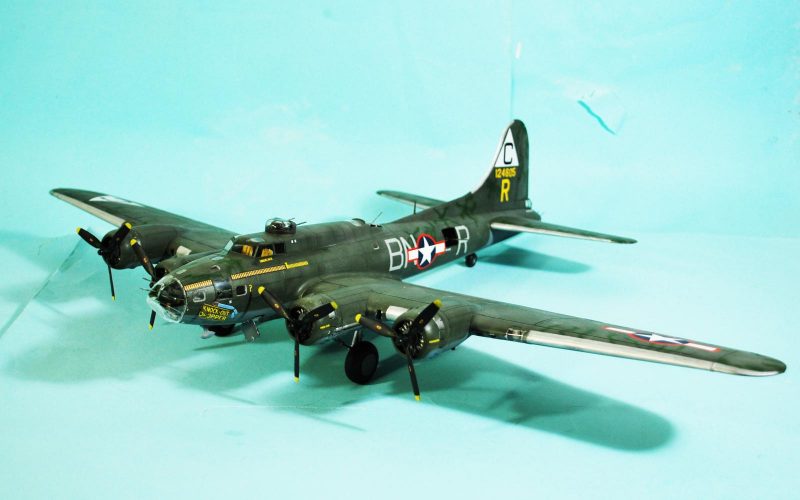
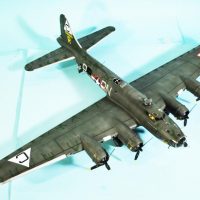
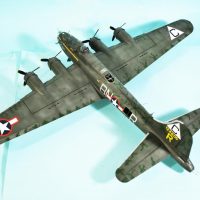

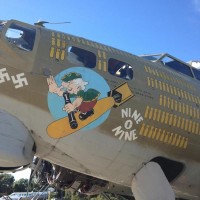
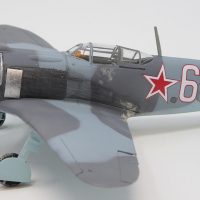
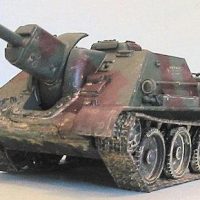
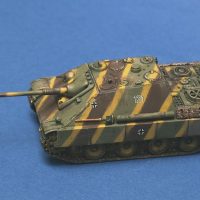
Wow. Looks great, Tom. I love the paintwork, weathering and markings. One day I will get my Monogram B-17G done. Can't afford the HK Models version but maybe next Christmas under the tree. Is it worth the price difference from the older kit?
That depends. The "knock" that the rear fuselage is "too deep" is true. As near as I can tell, it's about 6 scale inches too deep. Also, the outer engine does "ride high." If you want to trade that for all the detail you will never see (I even opened all the hatches, bomb bay doors, and internal doors to try and get a maximum of light in there and the final result is you can dimly see what's in there), plus outstanding fit, it makes a better model than the Revell B-17F, assuming you can find one. I had to laugh at a post over at The Central Office Of Those Who Will Never Be Satisfied, that "... I thought this was a great kit till I came over here and read the comments."
Myself, I can live with the fuselage and outer engines in return for nose caps with the internal gun mount for either the 1 or 2-gun set-ups and detail to do either an early Boeing "F" or a later Douglas "F".
Quite a nice F. I'm so used to seeing G models that it looks funny without the chin turret (kinda like seeing Groucho Marx without a mustache.)
Also looks weird seeing thru the cockpit windows and seeing the cockpit details.
Nice work. This is the first time I've seen camouflage for a b17 with the mottled dark green on the wing edges.
That was the B-17F. 1942-43 saw that camo on most USAAF aircraft. It was supposed to break up the outline, but wasn"t found to be very effective and was dropped about 6 months before camo overall was dropped.
Great job, as usual, @tcinla!
Looking forward to the full Modelingmadness review!
Incredible result, Tom @tcinla
The paintwork is very nicely done and I'm glad you shared your approach in the build thread.
It looks like a B-17 to me, and it’s a gorgeous model Tom. The weathered OD gives the model the sort of image everyone has of camouflaged Fortresses. Really nice model, one the best I’ve seen.
I dare saying no one noticed that higher placement of the outer engines until someone wrote it down in another forum...
You're to right, and this kit "corrected" the "major complaint" about the first (1/32) kit, that the top of the nose ahead of the cockpit wasn't "flattened."
I've been waiting for your take on this kit and I'm not disappointed. I will be checking out the full build review.
Very nice built! It seems to be a lot of work and paint 🙂
"Knockout dropper" is a knockout. Great job on the faded glory. The guy that applied the freakdrop green camo must have been artistically inclined. How that could be noticed at anything above 2000 feet is beyond me. Was an 8th Air Force field ever attacked? I haven't heard of such.
Considering that the B-17 was developed in the 30's and was a work in progress until the B-29 came along . . . seeing field green paint . . .If you where a bomber crew coming home on three or two engines loosing altitude with no cloud cover and wanting to be as small as possible against a green back round you'd try anything. Including adding more guns. Once the allies had control of the skies paint was added weight that could be used for more bombs.
The debate over adding interior details bomb bays, cockpits, turrets, and radio rooms raises the question why bother when no one can see it? What's my motivation? Yeah, to the casual observer who is interested in being entertained and wants to see a pretty plane or get a little history lesson while going to a show the kit is like a coffee table book. It becomes a conversation piece over cocktails and some cheese and crackers or a fun time for friends and family. Its fun to look at the canvas of plastic. On the other hand for those who build the kit perhaps someone who had a family member during the war or some one who is into engineering or likes to tinker and know how things work and answer some of the who, what and why questions for them selves and dig deeper into building the kit so that they have a better understanding of the B-17 have a good reason. Either way its all about entertainment and some folks like to document their build with photos during the build process and post these days. How we rationalize a build is always a question for the modeler and manufactures are willing to supply the goods and let modelers indulge themselves. That's entertainment.
Some things improve with age, I 've been following your articles and reading your books for years TC . Both the article and your gifts and talents in building and painting have gotten better with each passing year.
Two thumbs up.
Fantastic looking B-17 Tom! Also my first time I've seen this camo scheme, looks great.
I like how the new bars added to the U.S. insignia on the fuselage overlap the squadron code letters, just another badge of this particular airframe's longevity. I'm guessing not many B-17's with this type of camo made it that far into 1943.
Excellent choice of subject Tom, and a beautiful rendition of it.
Liked at least!
(Ed McMahon voice): "You are correct. sir!" 🙂
Looking good Tom! Might have to get one of these!
Don't go to all the effort to "open up" the interior. You just go from a black hole to a very dim hole. 🙂
Awesome B-17 build!
Great built and a beautiful paint work. Like so much.
Great looking build. I also like that unique squiggle camo addition. Great work on the paint job all around.
Wonderful as usual! A masterpiece! I like it. This give me inspiration for my future project: The 'Belle'.
Great build and review. The “Dropper” is my absolute favorite -17, due to its history and interesting markings (there are some good photos of her). Thanks for sharing.
Great build. The others beat me to the rest of the superlatives.
A lovely job - a fitting tribute to the real aircraft. Faded OD looks just right - and good to see none of the current and 'in vogue' patch-work quilt effects on this one!
Thanks very much, @vacform.
It's something "up your alley."
That's an impressive build Tom, nicely finished!
Great looking model, as usual, Tom. I have been thinking about this for a while, and since I recently picked up one of HK's F models, I figured it was finally time to ask: I notice that your F model is distinctly darker and "greener" than the G model you built. I am reasonably well-versed in the so-called regulations for such things, along with the endless variations when those were put into practice, but I am more interested in reproducing that earlier hue in modeling terms versus the historical research that I do all the time but which is of limited value when choosing a jar of paint (or two...) off the shelf.
Can you give a quick rundown of what you did differently in painting the upper surfaces of the F model to get the hue you achieved?